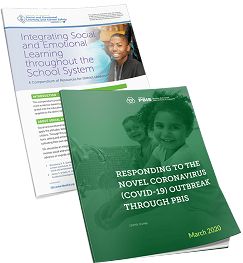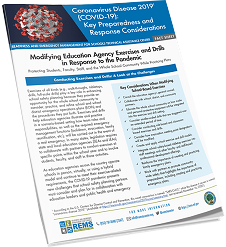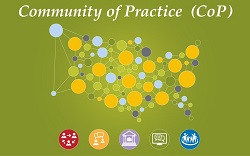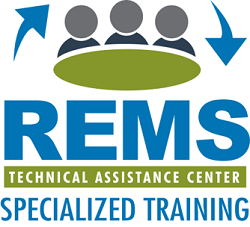|
Happy New Year! It is hard to believe that the fall academic season is over and that education agencies across the country are moving into a new calendar year and academic season. The U.S. Department of Education (ED), Office of Safe and Supportive Schools and its REMS TA Center would like to express gratitude to education agency leaders, essential staff, community partners, and other key stakeholders who went above and beyond in 2020 in response to the coronavirus disease 2019 (COVID-19) pandemic, hurricanes, wildfires, civil unrest, protests and demonstrations, adjusted teaching and learning environments, and more.
Perhaps more than ever before, our nation has come to collectively understand the important role that collaboration plays in helping to ensure that school and campus communities are prepared for the variety of threats and hazards that they may face. We applaud and appreciate your commitment to preparing and planning for a range of threats and hazards, and we want to remind you that we are here to support you. If you need technical assistance support at this time, please contact us at info@remstacenter.org or via phone at 1-855-781-REMS [7367]. We also encourage you to visit the REMS TA Center homepage and our COVID-19 Web page to access newly released resources developed by us and other Federal and national partners to support pandemic planning, response, and recovery efforts.

|
|
Understanding the Link Between Social-Emotional Learning and School Safety
It is no mistake that “prevention” is listed as the first National Preparedness System mission area. Education agency leaders and school safety planning teams will never be able to prevent all threats and hazards from developing into emergencies that require response and recovery. But they can integrate prevention and mitigation measures that aim to not only protect school and school district buildings and property but also, most importantly, provide safe spaces for teachers to teach, students to learn, and safe school communities to be cultivated.
Social-emotional learning (SEL) plays an integral role in sustaining a safe and supportive school community and climate. When schools and school districts prioritize SEL, they exhibit their overall commitment to and understanding of the role that student perspectives and experiences play in reinforcing school safety efforts and priorities. Specifically, SEL can do the following:

- Help ensure that students feel supported by adults in the school building. It takes only one trusted adult in the school building to make a student feel safer.
- Empower students to have a voice in overall school safety efforts and programs. Today’s students are tomorrow’s education agency leaders and emergency managers. When students feel they have a voice, they are more likely to feel connected and thus contribute to school safety goals and missions.
- Reinforce the role of trauma-informed care and multitiered systems of support in contributing to positive school climates. Each student enters the classroom door or accesses a virtual learning room with his or her own unique story and circumstance. School safety programs, protocols, and plans must be designed through a trauma-informed and equitable lens that considers the needs of the whole school community.
SEL has become increasingly important in the face of the pandemic as whole school communities (school leaders, educators, students, families, caregivers, and community partners) face new and unique challenges. ED’s Office of Elementary and Secondary Education and its technical assistance centers offer various resources to support education agencies with strengthening SEL programs:
Have an SEL success story, strategy, or lesson learned to share? Add it to the NEW Community of Practice (CoP) forum that we created for this purpose.

|
|
2021 Seasonal Preparedness Action Plan
Get ready for the new calendar year by creating monthly school and campus safety action plans. See our nation’s Seasonal Preparedness Calendar for an example.
-
January: Resolve to Be Ready by Creating a #MyPreparednessPromise
- Whether on your own or with your planning team, take time this month to create a preparedness promise using our creative campaign banners.
-
February: Show Your Emergency Operations Plan Some Love
- Use the REMS TA Center’s EOP Interactive Tools to assess your knowledge of emergency management topics, create or update your school or campus emergency operations plan (EOP), and/or evaluate its quality.
-
March: It’s Not Luck, It’s Preparedness
- Find time to practice portions of your school or campus EOP. (Stay tuned for a soon-to-be-released fact sheet on modifying exercises and drills in the face of the pandemic.)
-
April: Spring Forward
- Many schools will be modifying their plans for spring break, and the rollout of the COVID-19 vaccine will bring many new challenges. Visit the REMS TA Coronavirus Web page for up-to-date information. Use this time to help ensure that family contact information and required trainings, such as first aid and CPR, are up to date, and consider planning spring assemblies to remind your school community about preparedness plans.
-
May: Mid-Year and Summer Planning
- With many students falling behind academically, summer school may be essential for many students. Take this time to plan for or modify summer school, considering how to keep students safe and fed while learning at home or in person to help ensure continuity of learning.
-
June: A Focus on Site Assessments
- Conduct a mid-year site assessment of all school buildings and grounds using our SITE ASSESS Tool, and also confirm how site assessments should be adjusted based on any new challenges or trends.
-
July: Back to School Preparedness
- Schedule a “Reflect and Learn” session with your safety planning team to review lessons learned from the 2020 reopening season and to provide an open forum for all faculty and staff to provide perspectives on the strength of school and campus safety programs.
-
August: Professional Development
-
September: National Preparedness Month
- Outline a plan for how your agency will participate in this national engagement effort.
-
October: Great ShakeOut Earthquake Drills
- Register now to participate in drills in collaboration with the nation and your school campus community.
-
November: Thank Your Partners
- Keep a list of all the ways your partners support you during the year, and share it with them in November.
-
December: Celebrate Your Successes
- Schedule a celebration with your safety planning team and key partners during which you review all the ways you supported safe and supportive schools throughout the year.
|
|
Help Desk Request Snapshot
As education agencies across the country operate schools in person, virtually, or using a hybrid model and continue to meet their exercise-related requirements, the COVID-19 pandemic presents new challenges that school safety planning partners must consider and plan for in collaboration with education leaders and public health and emergency management partners. One such challenge is how to implement community mitigation strategies, like maintaining social distancing guidelines, which protect the health and well-being of students, faculty, and staff, while conducting exercises. It is important for education agencies to explore how to improve plans around exercises, while still maintaining their integrity and purpose.
There is no “one-size-fits-all” solution to the challenge of ensuring that exercise requirements are met in the midst of the COVID-19 pandemic. However, the REMS TA Center encourages school safety planning partners to review the following recommendations as they explore how to modify plans specific to conducting exercises and drills during this pandemic:

- Consult the education agency’s general counsel.
- Collaborate with school, district, and community partners.
- Educate the whole school community on how masks and personal protective equipment will be integrated into the exercise and drill setting.
- Consider smaller-scaled drills that are staggered over an extended period of time.
- Consider conducting role-based and classroom-based exercises and drills.
- Consider how evacuation meeting point designations will be modified.
- Create and apply virtual exercise and drill models.
- Integrate school safety-based tabletop exercises into staff meetings and other faculty- and staff-based professional development offerings.
- Reinforce the importance of creating and practicing family emergency plans.
- Work with partners to promote community-wide safety that highlights the importance of preparedness, including creating and practicing emergency plans.
Stay tuned for a soon-to-be-released fact sheet in which we dive deeper into each of the recommendations above.
For additional resources from Federal partners on COVID-19, visit the REMS TA Center’s Coronavirus Web page.
|
|
A Review of Our Synchronous and Asynchronous Learning and Engagement Offerings
The COVID-19 pandemic forced school districts to move instruction for all learners to an online environment. Schools adopted either a real-time (or synchronous) approach or a more flexible (or asynchronous) approach where students could log on and learn via online learning tools, videos, and materials at times that were more convenient for their family’s needs. These two types of learning environments extended to education agencies, including school districts, schools, institutions of higher education (IHEs), state education agencies, and regional education agencies, that had to adapt quickly to develop content with new tools and also adapt to synchronous and asynchronous learning for their own professional development needs.
Our synchronous and asynchronous training and professional development offerings are free. They are also designed to support individual, group, and agency knowledge- and capacity-building at the local, regional, and state levels. All topics are offered in varying modalities.
Synchronous
 Virtual Trainings by Request — designed to assist education agencies, including school districts, schools, IHEs, state education agencies, and regional education agencies, with their professional development and emergency preparedness capacity-building efforts. These events vary in length from 2 to 4 hours and are led by the REMS TA Center team of highly qualified subject matter experts, who come equipped with hands-on knowledge of emergency preparedness principles and practices in the educational setting. Virtual Trainings by Request — designed to assist education agencies, including school districts, schools, IHEs, state education agencies, and regional education agencies, with their professional development and emergency preparedness capacity-building efforts. These events vary in length from 2 to 4 hours and are led by the REMS TA Center team of highly qualified subject matter experts, who come equipped with hands-on knowledge of emergency preparedness principles and practices in the educational setting.
- Live Trainings by Request (currently suspended) — designed for delivery on-site at your school, school district, or IHE. Provided at no charge, each training offers training materials as well as one or more expert trainers and REMS TA Center staff support for the event hosted at your site. Training topics are offered on a rolling basis and integrate research studies, Federal recommendations, and lessons learned in the field.
-
 Twitter and CoP Web Chats – a virtual space designed for schools, school districts, and IHEs, with their community partners, to collaborate, share, and learn from the experiences of others in the field. Anyone involved in the field of school and/or IHE emergency management is welcomed to join this CoP of practitioners. The collective aim is to enhance the ability to develop high-quality EOPs and implement comprehensive emergency management planning efforts through the sharing of ideas, experiences, and lessons learned and by engaging with one another on these important topics.
Twitter and CoP Web Chats – a virtual space designed for schools, school districts, and IHEs, with their community partners, to collaborate, share, and learn from the experiences of others in the field. Anyone involved in the field of school and/or IHE emergency management is welcomed to join this CoP of practitioners. The collective aim is to enhance the ability to develop high-quality EOPs and implement comprehensive emergency management planning efforts through the sharing of ideas, experiences, and lessons learned and by engaging with one another on these important topics.
Asynchronous
- Webinars — audio- and video-enabled presentations that are available from experts in the field of school and higher ed preparedness and archived for viewing at any time. Webinar participants can download a copy of the presentation, supplemental resource lists, and other online materials that enhance key learning objectives.
- Online Courses — our online courses that guide users on federally recommended information and processes for high-quality EOP development and related topics in comprehensive emergency management. Course participants can take notes and download job aids, checklists, and reference guides as they navigate through informative course modules.
 Specialized Training Packages — self-paced emergency management training materials that support high-quality emergency management across a range of special topics. School emergency managers may use these materials to train their colleagues or to brush up on their own knowledge regarding special topics in school emergency management. Specialized Training Packages — self-paced emergency management training materials that support high-quality emergency management across a range of special topics. School emergency managers may use these materials to train their colleagues or to brush up on their own knowledge regarding special topics in school emergency management.
- CoP — a virtual collaboration space. Anyone involved in the field of school and/or IHE emergency management is welcomed to join, from members of emergency operations planning teams and law enforcement officers to community members and parents.
- Tool Box — a virtual library of tools developed by school and higher ed emergency managers in the field that contains resources pertinent to the needs of schools, school districts, state education agencies, regional education agencies, and IHEs, with their community partners, as they engage in emergency management planning.
- Resources — a variety of resources from the REMS TA Center, ED, and other Federal agency partners on key topics in K-12 and higher ed emergency management.
We also encourage you to visit the Training tab on our Website to access the variety of additional training types we offer, including Webinars, specialized training packages, and online courses. Visit the Tools and Resources tabs to access the other learning and engagement offerings listed above.
|
|
Virtual Networking Corner
This section of our newsletter features highlights from our interactions with the field via our NEW #REMSontheAir Podcast, Twitter, the CoP, and other virtual events and networking platforms.
 COMING SOON! #REMSontheAir Podcast COMING SOON! #REMSontheAir Podcast
The REMS TA Center is excited to announce the NEW #REMSontheAir podcast series, which is the latest resource offering we have created for ED to highlight real-life lessons learned from the field in this interactive audio format. Soon to be available for download on the REMS TA Center site, the #REMSontheAir podcast series will feature short interviews and informational segments on key topics specific to prevention, protection, mitigation, response, and recovery in the school and campus settings. Stay tuned for the official launch of #REMSontheAir, coming soon!
Recap of 2020 Webinars
Along with hosting various virtual meetings, listening sessions, and trainings with and for local, regional, state, and Federal partners in the field last year, the REMS TA Center offered Webinars to support education agencies with planning around COVID-19. Find a recap of the Webinars we offered in 2020 below:
Share and Request Webinar Topics and Ideas
We are always seeking requests for Webinar topics and ideas to cover. Have an idea? Email info@remstacenter.org, or send a note to Project Director Janelle Hughes or Strategic Project Director Bronwyn Roberts.
Top @remstacenter Tweets for the Quarter
When protecting student privacy in the at-home setting, it’s important to understand the variety of cyber threat types, including data breaches, spoofing/phishing, malware/scareware, unpatched or outdated software vulnerabilities, and use of removable media. Find information about cybersecurity at this link.
Did you know that @remstacenter has creative materials for public use to promote a safe and healthy learning environment for students and staff? Check them out, and download them here ⇒

|
If you have any questions or need additional assistance, please contact the REMS TA Center at
 1-855-781-REMS [7367] or 1-855-781-REMS [7367] or  via email at info@remstacenter.org. via email at info@remstacenter.org. |



